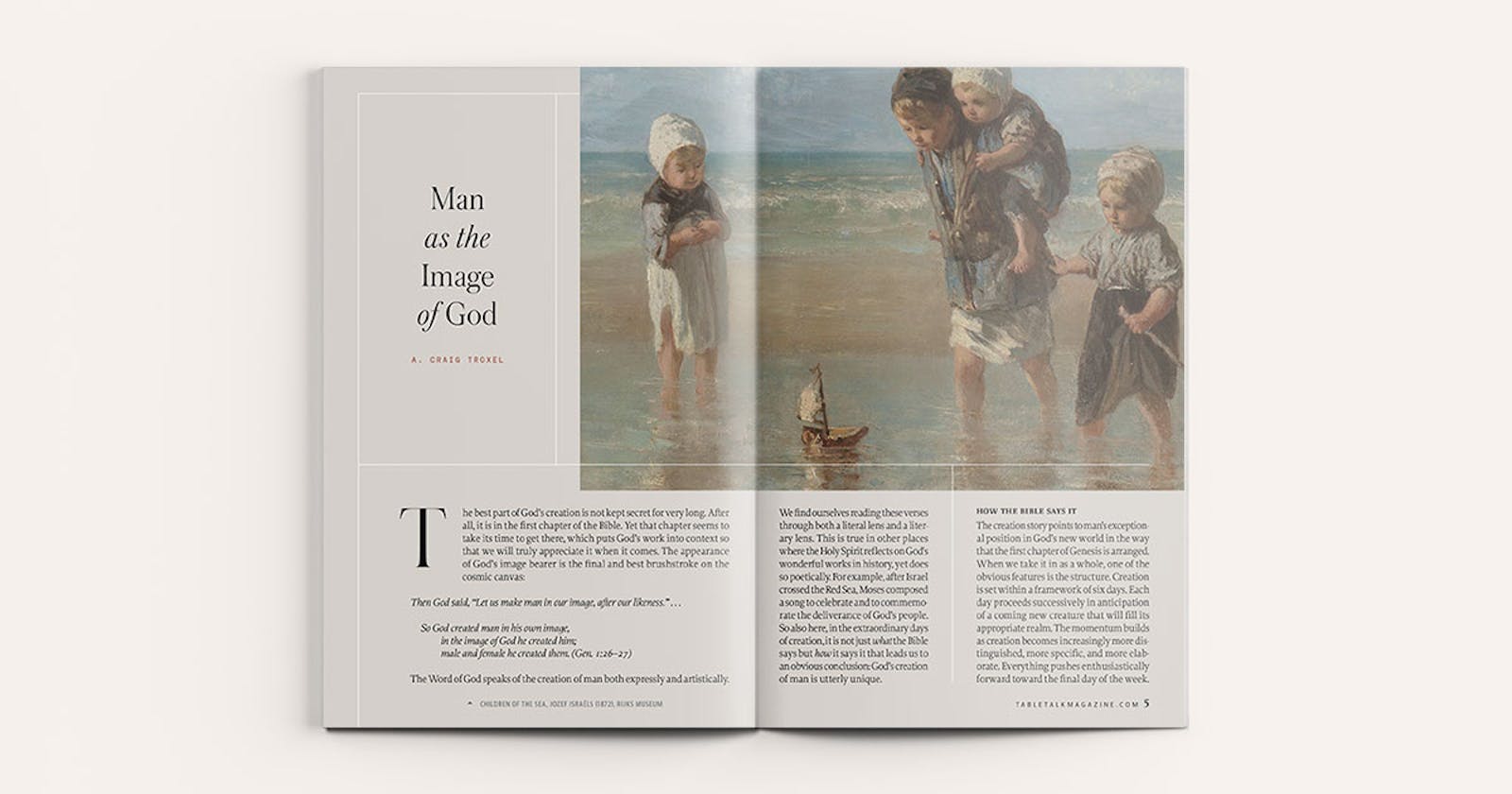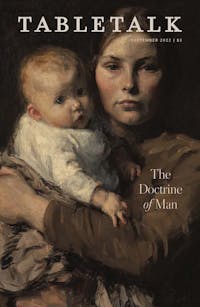
Request your free, three-month trial to Tabletalk magazine. You’ll receive the print issue monthly and gain immediate digital access to decades of archives. This trial is risk-free. No credit card required.
Try Tabletalk NowAlready receive Tabletalk magazine every month?
Verify your email address to gain unlimited access.
The best part of God’s creation is not kept secret for very long. After all, it is in the first chapter of the Bible. Yet that chapter seems to take its time to get there, which puts God’s work into context so that we will truly appreciate it when it comes. The appearance of God’s image bearer is the final and best brushstroke on the cosmic canvas:
Then God said, “Let us make man in our image, after our likeness.” . . .
So God created man in his own image,
in the image of God he created him;
male and female he created them. (Gen. 1:26–27)
The Word of God speaks of the creation of man both expressly and artistically. We find ourselves reading these verses through both a literal lens and a literary lens. This is true in other places where the Holy Spirit reflects on God’s wonderful works in history, yet does so poetically. For example, after Israel crossed the Red Sea, Moses composed a song to celebrate and to commemorate the deliverance of God’s people. So also here, in the extraordinary days of creation, it is not just what the Bible says but how it says it that leads us to an obvious conclusion: God’s creation of man is utterly unique.
how the bible says it
The creation story points to man’s exceptional position in God’s new world in the way that the first chapter of Genesis is arranged. When we take it in as a whole, one of the obvious features is the structure. Creation is set within a framework of six days. Each day proceeds successively in anticipation of a coming new creature that will fill its appropriate realm. The momentum builds as creation becomes increasingly more distinguished, more specific, and more elaborate. Everything pushes enthusiastically forward toward the final day of the week. When the sixth day finally comes (and only after God has brought forth all plant life and every animal), one creature remains to be presented: man, the crowning triumph of God’s spoken word. In case the reader fails to follow the stepping stones of these verses, the second chapter of Genesis doubles back to man’s creation and explains the unique place, privileges, and calling of mankind.
Looking at Genesis 1 more closely, we inevitably notice how the narrative of God’s work is accented with poetic features. Refrains and repetitions thread their way through the creation story.
God said, “Let there be . . .”
And God saw that it was good.
And there was evening and there was morning, the [nth] day.
These phrases create a cadence as we read the account so that the narrative falls into a comfortable rhythm. At least, this is true up until the creation of man, when the account suddenly breaks from its pattern. For the first time, God does not merely speak and something hastens into existence. Now the persons of the Godhead speak to one another as They delve into a thoughtful soliloquy over the culmination of all living things. The divine council reflects out loud on the significance of this new creature who is about to appear in the created order. No other element of creation is deliberated upon in this way.
No one but man is pondered over with regard to his unique duty, which is to steward creation and exercise dominion over it.
“And let them have dominion . . . over all the earth and over every creeping thing” . . . “Fill the earth and subdue it, and have dominion . . . over every living thing that moves on the earth.” (Gen. 1:26, 28)
No other kind is discussed in detail as having complementary genders of male and female.
So God created man in his own image,
in the image of God he created him;
male and female he created them. (Gen. 1:26–27)
Nor is creation praised as “very good” until the appearing of humankind (Gen. 1:31). Previously, creation was “good”—which is high praise. Now it receives its highest praise.
No other creature receives such a detailed account because no other creature compares. Humanity is God’s best work, and He suspends the rhythm of His unfolding story so that we will appreciate the introduction of creation’s most excellent creature. The structure and style of the text show us this. But the text also tells us this expressly when it says that humankind alone is created in God’s image.
what the bible says
If the way that the Bible presents the creation of man points to his importance relative to the rest of creation, then what the Bible says about man points to his unique essence relative to his Creator. The other creatures find their places in their respective kingdoms. Man finds his ultimate place in his relationship to his God. He is the only one in all creation who touches both earth and heaven. His very essence is that he is in fact made in the likeness of the God of heaven.
Then God said, “Let us make man in our image, after our likeness.” . . .
So God created man in his own image,
in the image of God he created him;
male and female he created them. (Gen. 1:26–27)

Man as the image of God is the most important assertion the Bible makes about creation. It shows that man’s priority in creation and his dominion over it flow from his essence as God’s image bearer. This indicates the underlying unity of the human race, which applies to humanity’s two complementary genders:“ ‘Let us make man in our image, after our likeness.’ . . . So God created man in his own image, in the image of God he created him; male and female he created them” (Gen. 1:26–27). God’s making “man” in His image parallels God’s making “them”—that is, “male and female”—in His image. Both are equals in this. Both male and female equally have fellowship with God. Both equally receive the knowledge of God’s moral will. Both equally share in the mandate to rule the earth by tending and guarding the garden sanctuary (Gen. 1:28). Without Eve, “it is not good that the man should be alone” (Gen. 2:18). With Eve, Adam has a companion who corresponds to him, understands him, and communicates with him—as his equal.
The unity of our race is rooted in the fact that every member of the human race is an image bearer. Every person we meet, no matter their particular ethnicity (or mixture of ethnicities), represents God’s best handiwork. That is enough for a person to receive respect and to be treated with dignity—no matter their sex, their race or age, or whether born or unborn, whether Christian or not. They are image bearers. They are our kind. How ridiculous it is to bless God and then in the next moment to curse a person, who is “made in the likeness of God” (James 3:9). How reprehensible and consequential it is to shed human blood, because “God made man in his own image” (Gen. 9:6).
God’s image bearers represent the best of God’s creation. Even if a person has not professed his faith in Christ as his Creator, Savior, and Lord, he is to be treated with the dignity that every member of our race deserves. He is fallen, but he is still a human being. The image is greatly corrupted in an unbeliever. But it is not irreparable. A fallen man is far from the ideal man, yet he is still a man. That is the greatness and the tragedy of the human race. Francis Schaeffer said, “There are no little people.” C.S. Lewis said, “There are no ordinary people.” The ones we encounter every day are those with souls, which nothing else in creation can boast.
In the physical creation, man is the lone spiritual correspondence between heaven and earth. This is what ultimately touches the core of our essence and our life’s purpose. It is to experience the realities of spiritual joy, eternal peace, and God’s steadfast love, all of which transcend this creation. As God’s image bearers, we were made to enter communion with our Creator. Our true life is in the things above, not in the things of earth. We lift our eyes in faith to our heavenly Creator and Redeemer and find our life in Jesus Christ (Col. 3:1–4). He was “born in the likeness of men” and suffered what we could not endure in order to procure what we could not earn (Phil. 2:7). Through His resurrection, God has raised us up to walk in the newness of life so that God’s image might be renewed in us (Eph. 4:24; Col. 3:10). This is the true essence of who we are and what we were meant to be, forever. It’s there in the creation story—both in how the Bible says it and in what the Bible says. And it is fulfilled in the gospel. We were made for this. We are being renewed for this.
